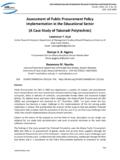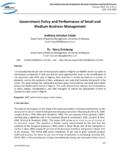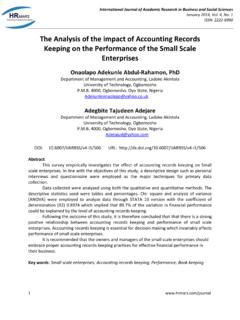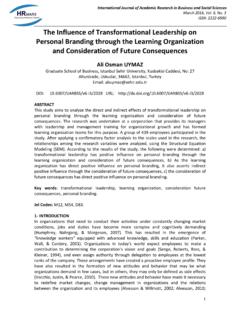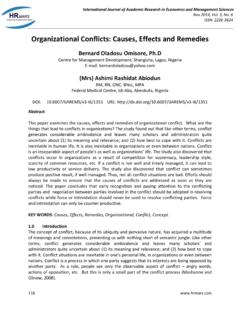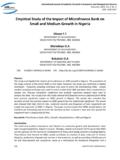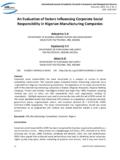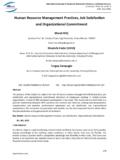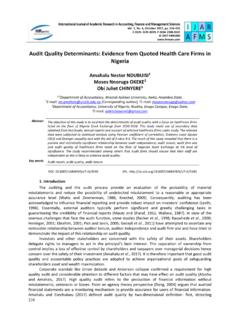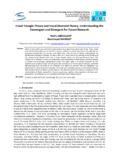Transcription of Impact of Capital Structure on Firm Performance: Evidence ...
1 International Journal of Academic Research in Economics and Management Sciences Sep 2014, Vol. 3, No. 5. ISSN: 2226-3624. Impact of Capital Structure on firm performance : Evidence from Pakistani Firms Tariq Javed Assistant Audit Officer, Government of Pakistan, Islamabad Waqar Younas Master of Business Administration, University of Arid Agriculture Rawalpindi, Rawalpindi, Muhammad Imran Master of Business Administration, University of Arid Agriculture Rawalpindi, Rawalpindi, DOI: URL: Abstract An attempt was made to analyze the Impact of Capital Structure on firm performance of 63. companies listed on Karachi Stock Exchange. Data comprised of 5 years, 2007 to 2011. Balance Sheet Analysis issued by State Bank of Pakistan was used for data collection. Fixed Effects Model was used as pooled regression model to find the relationship between firm performance (ROA, ROE, ROS) and Capital expenditure (DTA, EQA, LDA).
2 Results showed that there does exist a relationship but direction of the relationship was mixed. Capital Structure showed positive Impact on firm performance when retrun on assets (ROA) was used as dependent variable. When return on equity (ROE) was used as dependent variable then debt over assets ratio (DTA). showed positive Impact but equity over assets ratio (EQA) and long term debts over assets ratio (LDA) revealed negative Impact over dependent variable and when retrun on sales (ROS) was used as dependent variable then DTA and EQA showed negative link to ROS but LDA revealed positive Impact over ROS. It was proved that Capital Structure has Impact over firm performance so managers should adopt necessary carefulness while taking decisions regarding Capital Structure . Key words: Capital Structure , firm performance , Karachi Stock Exchange, Balance Sheet Analysis, State Bank of Pakistan 1.
3 Introduction: The decision about Capital Structure plays a key role in maximizing firm value and performance of a firm . The decision about Capital Structure occupies the use of a combination of various sources of funds which a firm uses to finance its operations and for Capital investments. These sources comprise the use of short term debt, long term debt, preferred stock and common stock or equity financing. All the firms do not use uniform Capital Structure ;. they differ in their financial decisions. It is a difficult task for managers to take decision about 28 International Journal of Academic Research in Economics and Management Sciences Sep 2014, Vol. 3, No. 5. ISSN: 2226-3624. Capital Structure where risk and cost is minimized and can give more profits and also can increase shareholder wealth. The relationship of decisions about Capital Structure with firm performance were suggested in a number of theories, most famous are Modigliani and Miller Theory (1958) and (1963), Agency Cost Theory (1976), Trade Off Theory (1977) and Pecking Order Theory (1984).
4 The Modigliani and Miller (1958) theorem which is also known as the Capital Structure irrelevance principle was proposed by Franco Modigliani and Merton Miller in 1958. They argue that under very restrictive assumptions of perfect Capital market, investor's homogeneous expectations, tax-free economy and no transaction costs, Capital Structure do not play any role in determining firm value. Their succeeding preference of entirely debt financing is due to tax shield, in 1963, was a denial to traditional approaches, which advise an optimal Capital Structure , Modigliani and Miller (1963). In actuality, determination of optimal Capital Structure is not an easy job, Shoaib (2011). He argues that a firm may need to issue a number of securities in a combination of debt and equity to meet an exact mixture that can make best use of its value and having succeeded in doing so, the firm has achieved its optimal Capital Structure .
5 Tradeoff Theory by Miller (1977) refers to the thought that a company prefers how much amount of debt finance and how much amount of equity finance to be used by considering costs and benefits. According to this, if firms are highly profitable, then they would prefer debt financing for increasing the shareholder wealth, further debt in a firm 's Capital Structure gives more tax benefits. If a firm has low profit, then there is a larger probability of bankruptcy if it uses more debt. Pecking Order Theory (POT) developed by Myers and Majluf (1984) according to this if firms have high profits, then internal financing would be used for new projects which can maximize the value of shareholders. If retained earnings are not enough, then debt financing is preferred and if additional financing is required, equity is issued. The choice of retained earnings is preferred because it has nearly no cost.
6 A range of research studies was performed to check the influence of the decisions of Capital Structure on the firm performance . As Capital Structure is chiefly based on two forms of finances that are equity and debt. Use of each form of financing explains the mixed and conflicting conclusion on firm performance . Jensen and Meckling (1976) express the sum of leverage in the Capital Structure of a firm influences agency conflicts among shareholders and managers, and so can change managers' behaviors and operating decisions, and it is proved by Ebaid (2009). The survival of information asymmetry is also a related concern in the decisions of the Capital Structure , Sheikh and Wang (2011). Environmental dynamism and competitive environment play a critical role in making the decisions of optimal Capital Structure . Berger and Patti (2006) have proved that there is a positive relationship between Capital Structure and firm performance , Margaritis and Psillaki (2007), Cheng, Liu and Chien (2010), Park and Jang (2013) have also supported Berger and Patti (2006) when they found reliable evidences of a significant relationship between Capital Structure and firm performance .
7 While, there is also a negative relation too between Capital Structure and firm performance , according to Antoniou, Guney and Paudyal (2008) and Soumadi and Hayajneh (2012). In this study, mixed results were founded regarding the Impact of Capital Structure on firm performance . Some determinants of Capital Structure showed positive Impact over firm performance while others showed negative. 29 International Journal of Academic Research in Economics and Management Sciences Sep 2014, Vol. 3, No. 5. ISSN: 2226-3624. The study is organized as follows: In second section, relevant literature is discussed which showed different relationships among Capital Structure and firm performance . In third part, testable hypotheses are developed. Fourth part is comprised of research methodology. In fifth part tests, results and discussions are explained regarding this study and study is concluded in sixth and last part and also showed some recommendations along with conclusion to this study.
8 Objectives of Study The study is conducted on non-financial firms fall under KSE 100 index of Karachi Stock Exchange. Objectives of study are as follows: 0 To find out if there is any relationship between Capital Structure and firm performance . 0 And if a relationship exists, then to find out direction of relationship that whether relationship is positive or negative. 0 In case of existence of relationship between Capital Structure and firm performance it would also be revealed in this study that to what extent Capital Structure affect firm performance . Limitations of Study There are total 652 companies listed on Karachi Stock Exchange (KSE) out of which non- financial companies were selected which were included in KSE 100 index, but due to unavailability of required data study sample reduced to 63 non-financial companies listed on KSE.
9 Balance Sheet Analysis (BSA) available on State Bank of Pakistan's (SBP's) website, was used for data collection and the data was from years 2007 to 2011 because data prior to these years, for some companies, was not available on SBP's website and data after 2011 was also not available there. of total firms were deducted due to unavailability of data. 2. Literature Review Raheman, Zulfiqar and Mustafa, (2007) conducted research on 94 non final companies listed on the Islamabad Stock Exchange (ISE) and used data from 1999 to 2004. Pearson's correlation and regression analysis to find relationship between Capital Structure and firm profitability were used and after analyzing financial statements of companies it is proved that Capital Structure does Impact firm profitability. After studying 400 companies from 12 sectors and listed on the Tehran Stock Exchange (TSE), Pouraghajan, Malekian, Emamgholipour, Lotfollahpour and Bagheri (2012) found that there is a significant relationship between Capital Structure and firm performance .
10 Nirajini and Priya (2013) used data of trading companies listed in Sri Lanka from year 2006 to 2010 and used correlation and multiple regression analysis and found that there is a significant relationship between Capital Structure and firm performance . There are mixed results about the influence of Capital Structure on firm performance . Some of the researchers have found a positive relation and some found negative while others have concluded that Capital Structure and firm performance are correlated by both ways, positively and negatively. We also found Evidence that there is no relation between Capital Structure and firm performance . By studying data from 1998 to 2002 of firms in Ghana positive 30 International Journal of Academic Research in Economics and Management Sciences Sep 2014, Vol. 3, No. 5. ISSN: 2226-3624. relation was found between firm performance and Capital Structure , Abor (2005).
